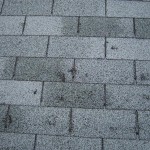Frequently Asked Questions
What effect does hail have on a Roof?
Shingles are designed so that the granules block the UV of the sun and protect the asphalt underlayment. As shingles age, the granules fall off over time. As the asphalt is exposed to UV, it dries out and the shingle and the corners begin to curl up. A shingle at the extreme end of its life is bubbled in appearance and is brittle to the touch. A 25-year shingle is warranted by the manufacturer to have a useful life, under optimal ventilation conditions, of 25 years. Hail does several things:
1. Accelerates granule loss.
2. Accelerates shingle aging.
3. Voids manufacturer’s warrantys.
4. Leads to other associated problems.
Should a roof be replaced immediately after hail damage?
The nature of hail damage is that it may pose no immediate threat to the structural integrity of the roof. However, many insurance companies have a “statute of limitations” for how long a hail claim is viable. If you have experienced a loss due to hail damage, it is prudent to take care of the problem in a timely manner before it leads to other additional problems
What does a hail hit look like?
A hail hit on a shingle looks like a “bruise” or a dark spot where the granules on the shingle have been knocked off and the asphalt underlayment, and at time, the fiberglass mat is exposed. New hail hits will have a shiny appearance because the asphalt has been freshly exposed and has not had time to weather to a dull color.

Visual of Hail Damage

Hail Damage Close View
Why do insurance companies pay for a roof replacement?
The purpose of property insurance is to protect the property owner against losses in the property value due to damage that is beyond the owners control. If you have hail damage, you have experienced a financial loss in that your original investment of a 25-year roof (for example) has now been reduced to a 5-10 year useful life span. Your insurance company will compensate you for your loss and replace your roof.
In my adjustment, my insurance company deducted some money for depreciation. Am I responsible for that portion?
Different insurance companies call the amount that they hold back different things. Some call it depreciation; other companies may show it as a dump and removal fee. What it represents is the amount of money the company will hold back until they receive a signed contract from you and a contractor for the work. When they receive a signed contract, you will receive another check for the amount they have held back, less your deductible.
My insurance adjuster said there was no hail damage on their first inspection. However, on the re-inspection with Contender, the adjuster concluded that there was hail damage and “totaled” the roof. Why such a dramatic turn around?
There are many different reasons that this happens. Sometimes adjusters get to a roof too soon after the actual damage and the hits haven’t had a chance to weather yet. Sometimes the adjusters are inexperienced. The best results are obtained when an experienced roofer walks through the inspection with your insurance adjuster. Your Contender Construction representative can then point out any damage to your insurance adjuster.
